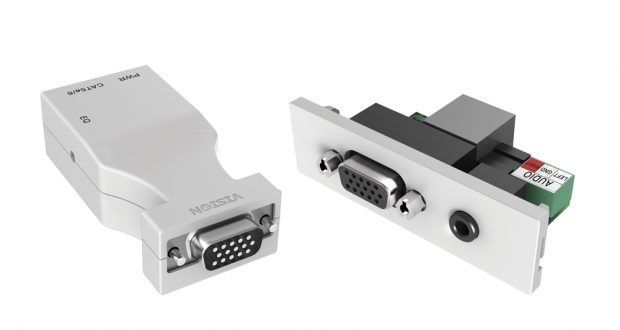Vision details changes in technology and explains what most people don’t know about HDBaseT.

Heard of LVDS? It’s the native signal that carries video around your computer motherboard. In 2010 Intel and AMD announced that by 2013 DisplayPort will replace LVDS as the native signal. All of the major computer manufacturers added that by 2015 all VGA outputs would be replaced with DisplayPort and HDMI.
Which format will replace VGA?
DisplayPort suits our needs better, but HDMI had a massive head start. So for now they will share the role of replacing VGA. But in our industry the physical cable replacing VGA will be twisted pair – aka CAT5e and CAT6. CAT5 is common, often already flood-wired, and is easier to work with. Using infrastructure cable as a ‘runner’ between conversion baluns future-proofs installations in case a new signal format is introduced.
VGA over CAT5
The first step in preparing for this new reality is to start using CAT5 now – even if you’re still terminating with VGA at each end. Vision’s VGA over CAT5 solution sends VGA over a CAT5 cable up to 60m long. This inexpensive device costs roughly the same as installing a 20m VGA cable.
HDMI over CAT5
Vision’s most basic HDMI over CAT5 solution comes in the same form as VGA over CAT5 products. It sends HDMI over CAT5e cables up to 30m long, and CAT6 cables up to 50m long. It converts and amplifies the signal over all four twisted pair wires.
HDMI over CAT6 – HDBaseT
HDBaseT is the most important technical innovation in recent times. It allows up to five signals to pass through a single CAT6 cable at the same time without compression. So for example this could be two HDMI signals, RS-232 signal, component video, and up to 100 watts of power at the same time. And the cable can be up to 100m long.
Eventually all flat panels will have a single RJ45 socket for all of the inputs and power. Right now only smaller 30in LED flat panels use less than 100w of power, but as larger screens become more efficient Power-over-Ethernet will become common.
Eliminating the power supply will allow flat panels to be thinner, lighter, and less expensive.
HDBaseT is in the early adoption stage, so the full five signals at the same time isn’t supported yet, and the chipset is very expensive. But this is the technology that has enabled CAT5 to take the prime position as a capable replacement for VGA.
HDMI over CAT5 – IP
Vision’s Techconnect HDMIIP converts HDMI into TCP/IP packets to run over a local area network. In other words it allows you to patch HDMI from one room in a building to another via the existing LAN infrastructure – through up to three network switches. The maximum length of CAT5 cable between network routers, hubs, and switchers is 100m, so the maximum theoretical length is 400m.
To squeeze the HDMI signal into TCP/IP packets the HDMIIP uses jpeg compression at 30 frames per second. To put this in to context television is filmed at 25 frames per second, so it is impossible to tell there is compression. There are no compression artefacts and no latency.
These solutions have really only just got up to the quality required for professional AV. They are less expensive than HDBaseT solutions and are particularly well suited to digital signage applications.
Originally Posted on: http://www.avinteractive.com/features/cutting-edge-technology-report/vga-is-finally-dead-03-09-2013/
Editor: Andrew Lee
